Soldiers on the Border
Five years after 9/11, Washington's War on Terror changes life in West Texas
Under the night sky an armored skybox lifts its sleek head from the sand and rises into the air on hydraulic legs, jerking into place like some monstrous desert insect. At the controls, a 21-year-old Texas National Guard soldier packing a 9 mm semiautomatic sidearm watches a gray-toned screen, where figures tracked by a night-vision camera appear from behind a mesquite bush, duck behind it again, then materialize once more, moving north toward the Rio Grande. The soldier, recently returned from Iraq near the Kuwait border, watches alone in the air-conditioned box. He’s looking for illegal border-crossers, just as he searched out “the enemy”—the object of military reconnaissance—in the other desert. From this height, an irrigation canal winds slender and graceful as a rivulet below, under a half-moon that gives just enough light to confuse the naked eye about what it might be seeing in the distance. People? Animals? Iraq prepared him for this mission, the soldier says, with experience in “staying vigilant, alert.”
Later, on the ground, the soldier’s partner emerges from a white vehicle parked on the canal road, packing his own Beretta, wearing a couple of ropes of extra ammunition around his neck. Will he have to use the weapon? The soldier, dressed in camouflage, stands in the dark with a million stars behind him. “I doubt it, but if I have to, I’m prepared,” he says.
Five years after the events of 9/11, this is what the war on terror looks like on the West Texas border. During a rare, prime-time television address to the nation in May, President Bush announced Operation Jump Start: the deployment of 6,000 Guard troops from San Diego to Brownsville, an increase in Border Patrol personnel from its current strength of 12,000 to 18,000, and “bringing the most advanced technology” to the border line, including the kind used in Afghanistan and Iraq: more infrared cameras, motion sensors, unmanned aerial vehicles. Because of rotations, the number of National Guard expected to serve on the border in the next two years will reach into the tens of thousands. Yet Bush insists, “The United States is not going to militarize the southern border.”

But the terror war here is not just marked by the coming of soldiers. It’s a campaign marked by elements of low-intensity conflict, or LIC. That is the same doctrine, codified during the Reagan administration, which shaped U.S. assistance to Central American countries in the 1980s. Areas were militarized to control local populations while insurgencies flared. There’s no insurgency here, but there are drug runners and unlawful immigrants. LIC includes military deployment, such as that of the Guard, and paramilitary presence, like the Minutemen, but it’s more. It’s a doctrine that blurs the lines between civilian and military, and between local and federal authorities. It’s a doctrine that calls for militarization in the name of national security, turns civilians into suspects, puts rights at risk, changes the air, uses fear as a tool of control.
In San Elizario, a town near the skybox, neighbors often come over to Ray Carrillo’s on afternoons when they want to drink a beer and shoot the breeze, and lately to talk over the change in atmosphere, a feeling like the coming of war. They call Ray Camaron, either because he was red as a shrimp when he was born “or because I’m real short.” It’s not just the soldiers they talk about. Citizen militias like the Minutemen–a local one is called the Border Regulators–have appeared. And they talk about the sheriff. From January to June, the El Paso County Sheriff’s Department jumped the firewall between local and federal authority, setting up Operation Linebacker blockades in colonias and towns like this one, asking even U.S. citizens who looked Mexican to present papers.
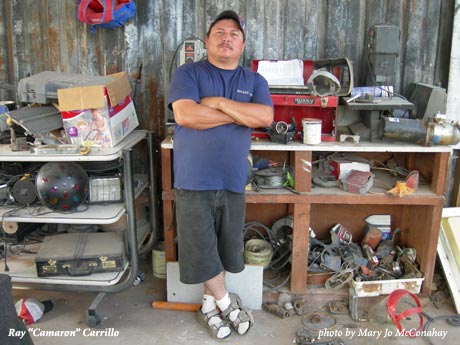
Late in 2005, Gov. Rick Perry initiated Operation Linebacker “to increase both public safety and national security,” distributing $10 million to date to 16 border sheriffs’ departments. Perry’s Linebacker is a politically mindful, “get-tough” stand, taken while immigration is exploding as a national issue. It plays well to voters who can be convinced that we have “lost control” of the border. But the cost can be high. El Paso deputies detained 860 undocumented persons under Linebacker in the first half of 2006, many with deep roots in local communities, and turned them over to the Border Patrol. Rights monitors claim public safety is being undermined because residents have become more afraid to call law enforcement for any reason, out of concern they will be asked for documents. Arguably, the air of mistrust also crimps any search for bona fide terrorists, work that depends greatly on community policing and intelligence. Not every sheriff’s office in the coalition uses Linebacker funds the way El Paso does. Local enforcement chooses how grants are spent. Yet Linebacker’s motivator statewide is national security, central to its drawing power for funds, and it’s the kind of sanction that gives a green light to local law enforcers to become de facto federal law enforcers.
One day Carrillo, a U.S. Navy veteran, stood in his welding yard, amid machinery and tankers under repair and barking dogs. He pulled out his cell phone and called the Spanish language TV station in El Paso as neighbors and his workmen were being picked off at the roadblocks. It was a cry for help, or at least for some attention from the wider world. “I’ve lived here 24 years, and there’s been nothing like this before,” says Carrillo, a 36-year-old father of two.
“That’s the Torres house, that’s Martinez, that’s Garcia–he’s in the service–and that’s Telles, the one they named the street over there for,” says Carrillo on a ride through town. He waves at the driver of a passing truck. “And there goes my brother.” This part of San Elizario began as a rough colonia, unimproved lots where families have seen water come to houses only in the last few years, although many, like Carrillo’s mother, don’t have gas yet, and sewage systems are still a dream. That means part of Camaron’s business is modifying the trucks that go around cleaning septic tanks. He sweeps an arm to take in concrete brick houses rising among the nopales and pink tunas, and a developer’s sign that announces: Coming Soon – Mission Style, 31 Lots. Progress in making colonias a decent place to live has come hard, but now people are scared. Households have always been a mix of citizens, legal residents, and undocumented relatives, but the war on terror is changing lives. Take a ride around other colonias east of El Paso—Agua Dulce, Sparks, around Horizon and Montana Vista—and you hear more. For weeks during the Linebacker stops, neighbors brought food and diapers to houses where fathers had been taken by authorities and mothers didn’t dare go into the streets. Priests reported churches vacant. A clinic usually bursting with the uninsured stood empty of families, the sick unattended. Today those who are undocumented, and relatives, remain uneasy. Around San Elizario the occasional Lazy Boy or old sofa in a yard sits empty. “People used to walk around more, used to walk down along the edge of the cotton field over there along the river for exercise, late in the day,” says mechanic Jessie Rubio, 46, a friend of Camaron’s.
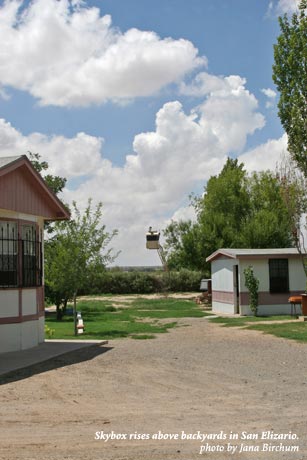
On a July morning, as Rubio spoke under a shade tree outside the family’s trailer home, his 11-year-old son, Jose Luis, tinkered with a car engine, and a lone, white egret was the only other creature visible in the expanse between Rubio’s yard and the line that marks the border. “What if a Minuteman mistakes me and shoots me?” he asks. Then there’s the Guard. “They can make a mistake with somebody taking a stroll, because now there’s too many guns and too many people. Somebody will say, ‘I’m an American, you can’t tell me what to do,’ and there’ll be trouble. Sometimes you get mad when you get asked so much for papers. You feel racism starting to climb. You can feel the tension.” Being asked for papers to go to the store “felt like those countries you hear about where soldiers and police are taking over and can search you,” says Rubio, whose parents immigrated from Chihuahua when he was six. He votes, and like other residents, is pleased when he reads the Border Patrol has busted drug runners. “They could hurt my son,” he says. But Rubio feels less ownership of his neighborhood now, questions why it’s feeling like a front line, and senses danger. “In a war situation you’re looking at people and asking, ‘Friend or foe?’ Well, now you’re getting people coming in from different parts, the Guard and Minutemen, and here we all look the same. In a war zone they don’t know who is who.”
Guard spokesmen reiterate that soldiers have authority only to call in the Border Patrol, not to arrest suspicious persons. Yet on the ground, fear of running into a soldier and being challenged is far greater than running into a Border Patrol agent. Partly this is because agents are familiar, but the soldiers are not. Partly it’s because residents see soldiers at war on TV every day, pictured amid explosions and in combat, then, disconcertingly, see them behind their back yards. And partly fear rises because residents know soldiers who are trained for war, or recently returned from war, may have a mind-set that doesn’t belong in the neighborhood. It’s not an outlandish concern: Veterans Affairs Secretary R. James Nicholson told The Washington Post in October 2005 that 12 percent of returning troops from Iraq and Afghanistan seen at Veterans Administration facilities suffered from some degree of post-traumatic stress disorder. But Suzanne Dennis, an Air Force veteran of Desert Storm who returned six months ago from Baghdad deployment as a public affairs specialist with the Texas National Guard, dismissed anxiety about stressed-out soldiers on the line. “They just switch gears,” Dennis says, from the battlefield to assisting the Border Patrol. “If you can’t switch, you don’t belong there.”
Nevertheless, for those in houses near the line, living in the zone now brings a sensation of the ground shifting under their feet. For Ray Carrillo, it also comes with a hunch his role in life is changing, because what is experienced as repression demands a response. “It just clicked,” says Carrillo about the moment when the Linebacker roadblocks were in full swing and the Guard was beginning to arrive. “It’s illegal to ask somebody for papers without suspicion of a crime. It’s not right for people to be afraid to come out of their houses.” His wife wants to move a few miles east to Fabens, but now Carrillo is deciding to stick around, staying in touch with rights groups, monitoring, listening, “protecting my rights, my kids, my neighbors.”
“I didn’t just throw a rock and run,” says Camaron about the roadblocks. “I stood my ground, in the light.”
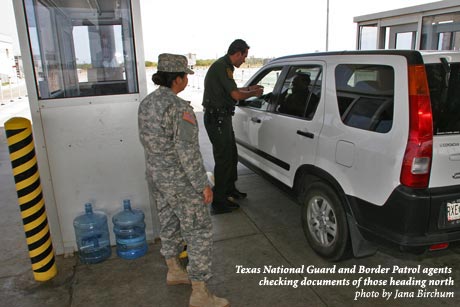
President Bush, the Border Patrol and the military declare the border is not militarized, but it is. Experts say it began years ago. In 1986, President Reagan issued a directive designating illegal drug traffic as a threat to U.S. “national security,” which permitted the Department of Defense to enter a range of “anti-drug” activity, including on the border. Even before that, in 1981 Congress passed amendments that diluted the strength of the 100-year-old Posse Comitatus Act, which had strictly prohibited deputizing military to carry out domestic law enforcement. The Pentagon’s Center for the Study of Low Intensity Conflict helped design the Border Patrol’s “Strategic Plan: 1994 and Beyond,” devoted almost entirely to immigration control.
The rhetoric of violence has taken over in a new way since September 11, 2001, replacing the language of immigration enforcement, border policy, or even drug interdiction with the language of fighting terrorism. When Gov. Perry’s Border Security Plan announced support for Operation Linebacker, its overview began with these words: “Al-Qaeda leadership plans to use criminal alien smuggling organizations to bring terrorist operatives across the border into the U.S.” Douglas T. Mosier, Border Patrol spokesman in El Paso, says, “Our primary objective now is preventing terrorists and instruments of terrorism from entering.” Rick Glancey, spokesman for the El Paso County Sheriff’s Department, says its job is the “same as the Border Patrol, preventing terrorism.”
“Every day you have drugs coming in duffel bags,” says Glancey, who is also interim executive director of the Texas Border Sheriff’s Coalition and helped develop Linebacker. “Today narcotics, tomorrow weapons of mass destruction. Since September 11 we’ve seen the border is perfect for someone to take advantage of the United States. We will not let this happen on our watch, Mr. and Mrs. America, you can be sure of that.”
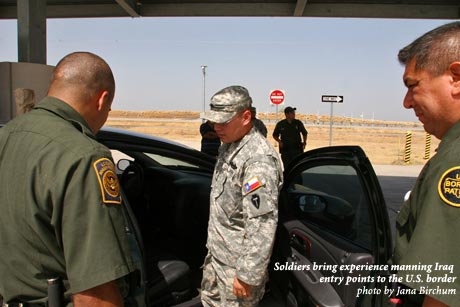
In his downtown office, where a side table is spread with baseball hats from other lawmen’s offices, Sheriff Leo Samaniego looks like a courtly grandfather, tall, 70-ish, smiling, at ease with his reputation as master of one of the best-regarded departments in the country. A civil-rights lawyer who has sparred with him legally says, “His roadblocks were a bad call, but this guy’s a great sheriff.” Samaniego is unrepentant about his “traffic stops” and insists they “will start again.” He halted them only temporarily, he says, to “cool off” the rights groups and citizens like Camaron, who had begun receiving attention with their complaining. The fact is that 9/11 has “definitely” changed his job, the sheriff says, and there’s no going back. “I’d rather be accused of overstepping my authority than sitting on my butt and doing nothing while we’re in war,” he says.
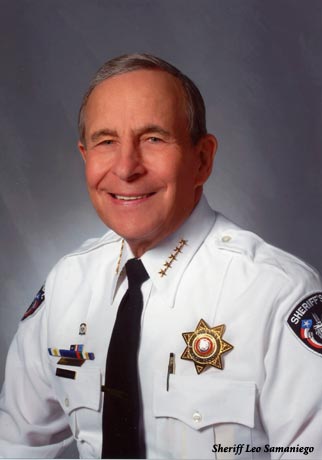
If the lines between local and federal authorities are blurring, so are lines between civilian and military operations. This landscape looks like Iraq. Units have arrived to assist the Border Patrol before going to the Middle East. “You can bet it can be beneficial to them,” says Mosier. “They’re getting used to a desert environment you can’t get at a base in the East or the Midwest.” Troops bring advanced military technology, different and better than what the Border Patrol has, and which only the military has the training to run. “Equipment such as that tried and tested in the Middle East can be beneficial in this kind of topography,” Mosier says. “If that technology is applicable and feasible (there is) no reason to think it won’t be considered for future use.”
For Mosier, having soldiers
on the border is not militarization, but “homeland security in support of a very real and vital mission.” From th
Border Patrol to the National Guard, the word is consistent: Soldiers in Operation Jump Start, President Bush’s initiative, have no direct law enforcement duties. They are here to provide force protection, free up Border Patrol agents until more can be trained, bring technology, to be “more eyes and ears.” But the reality is that soldiers are trained to kill and deal with an “enemy.” Local residents understand this. When the nearby city of Sunland Park, New Mexico, received a request from the Border Patrol’s El Paso sector to station National Guard soldiers on the city’s hill of Cristo Rey, a pilgrimage site topped by a monumental white cross visible from Mexico and frequented mostly by faithful from Texas, residents rebelled. The City Council voted to deny the right-of-entry permit. “Militarily trained is not Border Patrol trained,” says a 35-year-old El Paso native who picnics on the hill. “The Border Patrol doesn’t walk up to you with a weapon pulled–people are afraid of others running around there with M-16s.”
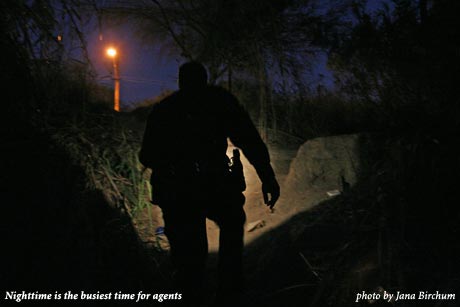
There is another reason more military personnel will be coming to El Paso: Fort Bliss is set to receive 20,000 new soldiers in the next five years (present number: 13,000). Spokesmen say the influx is not part of a strategy to strengthen military presence on the border, but due instead to re-stationing of units from overseas and from installations closed in the armed forces’ Base Realignment and Closure process. Did the strategic border location of Fort Bliss affect the BRAC decision not to close it, when the process eliminated so many others? “Not to my knowledge,” says Public Affairs Officer Jean Offut. Furthermore, the base “has nothing to do” with National Guard stationed in and around El Paso, or with their assignments.
No matter what the reason for supersizing Fort Bliss, the effect is a sensation of further militarization of the community, says Timothy Dunn, a border scholar (The Militarization of the U.S.-Mexico Border 1978-1992) and sociologist at Salisbury University in Maryland. “Also, that means there’s a much bigger pool to draw upon for border duty by JTF North.” Originally called JTF-6, in 1997 Marines in the anti-drug joint task force, supporting the Border Patrol, shot and killed an 18-year-old American named Esequiel Hernandez as he tended family goats in rural Redford, Texas. The Marines were never charged. JTF-6 morphed into JTF North, based at Fort Bliss, now charged with supporting law enforcers such as the Border Patrol with “interdiction of suspected transnational threats.” That’s fence and road building, but it’s also training, and that’s “not innocuous,” says Dunn. “It’s militaristic stuff including interrogation techniques, booby traps and weapons. A large part of low-intensity conflict doctrine always has been U.S. military units training local forces. What happens is that military thinking comes to have a role in civilian enforcement.”
Nearly half the 11 million undocumented immigrants in the United States entered legally and overstayed visas. Most illegal drugs enter in otherwise legitimate cargo and traffic. Operations Jump Start and Linebacker don’t affect them. Meanwhile, the poor of Mexico and Central America continue to regard work in the United States as a lifeline, even if they must come illegally to grab it. Absent coherent domestic and multilateral policy, the war on the border, like the war on terror, is endless, and increasingly dangerous. “It’s like two tsunamis, one coming up from the south, and increased militarization coming from the north, set to clash at the border,” says University of Texas at El Paso political scientist and border researcher Tony Payan. “There is a need for a way to accommodate the flow.”
In a new study, The Three U.S.-Mexico Border Wars: Drugs, Immigration, and Homeland Security, Payan suggests that the “real failure” of 9/11 was the lack of intelligence coordination to detect and apprehend potential terrorists entering anywhere. Mexican border security became a special focus, with law enforcement redefined as a matter of national security. The focus carries hostility not only to crossers but those who live in the area, “an escalation that has not paid off” because workers and drugs are coming at the same rate as five years ago. What has changed toward undocumented workers since 9/11, as Payan puts it, is “the perception of intentionality,” that “this is not someone coming to take a job, but someone who will harm America.”
Under a midday sun, the skeleton of a big river crab lies intact on the flat, baked earth. Which of the twigs coming out of the ground are motion sensors? Which are bare plants? A green and white Border Patrol car appears out of nowhere. The agent asks a few questions and seems in no hurry to drive away. He’s been on the job 16 years, he says. Sure, it’s fine that the Guard are here, but he doesn’t figure it will change his job much, endlessly patrolling this line. Has he ever been in danger? Well, the drug runners have taken to throwing big rocks at the patrol cars, which is dangerous if one hits while he’s driving fast. Sometimes the rocks smash right through the windshield, which cuts off the chase because it’s all you can do to keep the car from flipping. He wants to make sure I’m not confused, not thinking it’s the migrants trying to sneak into the country who throw the stones. “It’s the drug ones, you know, not the ones coming to work.” Later, on another part of the line where bushes grow, where it’s possible to climb down to the cool river, where a Mexican family on the other side has spread its cloth to eat lunch, another agent drives up, this one brusque. “Be careful around here, like if you go down to the river, because if we see you coming up, we don’t know who you are,” he says.
On another day, as light fades in the August sky, Texas National Guardsmen inside a windowless camera room are intent on a bank of full-light screens and pink-toned night vision screens, working joysticks to pan the views, watching “bodies,” as they call them, figures on the Mexican side of the river. “I was doing basically the same thing in Iraq, entry points, vehicles, looking for suspicious activity,” says a 33-year-old from El Paso back from Tikrit. “There they were penetrating the wall around our base. This is like they’re penetrating our home. We don’t want terrorists to come in.” Another soldier watches for “massing,” a gathering of several figures who might come across in a group and overwhelm a single agent. But El Paso has been flooded with rains, and the same river that was low just a few days before runs full and treacherous now. “You’d have to be crazy to try that river tonight,” says a 20-year-old Specialist 4. “Or desperate.”
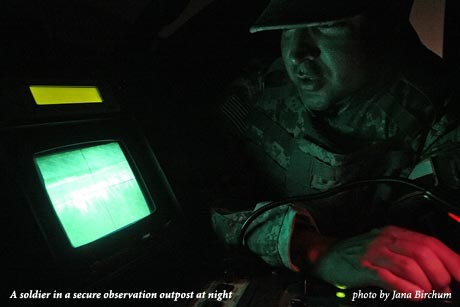
Nevertheless, hours after sunset Senior Border Patrol Agent Rogelio Garcia is driving the levee roads, amid tumbleweeds that blow up in the dark, catching jackrabbits in the headlight beams, his radio crackling with traffic from soldiers in the camera room and agents on the borderline who are spotting the crazy, or desperate, crossers. Visual on six to eight subjects… Changing clothes… Bodies up on the levee now… Those bodies are running back now… Garcia throws the SUV into four-wheel drive, driving expertly, ready for sinkholes on flats near the marsh. Another radio voice. Five to six subjects. Goin’ up. Running north from Duty exit. “Well, night is the busiest time,” says Garcia, who joined the Border Patrol six years ago. Two spotters… Four guys crouching… Agents respond. Outside San Elizario, Garcia rolls to a stop. From the levee an agent in a patrol car is “cutting” north across the sand with his flashlight beam, looking for tracks. Dogs are barking; other agents search a yard with flashlights. Garcia peers into a ditch. For now, they get away. Watching these agents, it’s clear that they are well trained, ready for anything. Some have specialized degrees, many served in the armed forces themselves. Deterrence through ubiquity and obvious surveillance is the policy, but if someone breaches the line, they know the pathways. It seems tonight that only the sheer number of those who try to cross the border illegally means some get through.
Garcia drives more miles along the borderline, until he pulls up alongside a white pickup. Inside, an agent is behind the wheel, watching a small, green screen divided into quadrants mounted on his dashboard. Standing high in the truck bed is a FLIR, or forward looking infrared camera, trained south. Only days before, a lone patroller nearby captured a group of 10 migrants, and two drug runners with 90 pounds of marijuana in duffels. Without the FLIR, says the agent at the dashboard screen, that lone patroller would have caught the escaping drug runners, but missed the drugs they jettisoned, which the FLIR’s eye saw. Garcia is thoughtful. “Every day what we’re doing out here is a war against terror–after 9/11 that became number one,” he says. And “you can’t say it’s militarizing the border” to have the soldiers here. “You don’t see military vehicles running up and down the line, and again, the Guard has no direct power to arrest.” The desert is silent except for the cry of cicadas. The FLIR agent never takes his eyes off the screen, and suddenly he is sending a message. One spotter trying to get on the river… Should pop out any minute…
Mary Jo McConahay is an independent journalist and contributing editor for New America Media.


